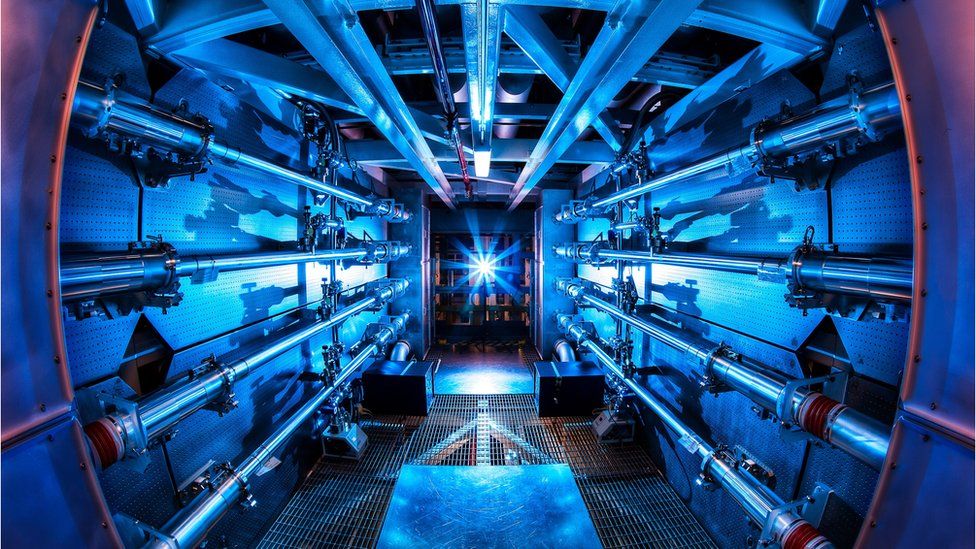ARTICLE AD BOX
 Image source, Lawrence Livermore National Laboratory
Image source, Lawrence Livermore National Laboratory
The National Ignition Facility in California houses the world's most powerful laser
At 1:03am on Monday, 5 December, scientists at the National Ignition Facility in California aimed their 192 beam laser at a cylinder containing a tiny diamond fuel capsule.
That powerful burst of laser light created immense temperatures and pressures and sparked a fusion reaction - the reaction which powers the sun.
The National Ignition Facility (NIF), part of the Lawrence Livermore National Laboratory, had done such experiments before, but this time the energy that came out of the reaction, was more than the laser power used to trigger it.
Scientists have been trying for decades to meet that threshold and the hope is, one day, to build power stations that employ a fusion reaction to generate abundant, carbon-free electricity.
That's still some way off. In the meantime, much work needs to be done in developing the technology.
Image source, Lawrence Livermore National Laboratory
Image caption,Developing the target fuel capsule has taken decades of work
One of the key components at NIF is a peppercorn-sized synthetic diamond capsule, which holds the fuel. The properties of that spherical capsule are crucial to creating a successful fusion experiment.
The sphere has to be perfectly smooth and contaminant-free - any anomalies could ruin the reaction.
Those precisely engineered spheres are not made in California though. They are the result of years of work by Diamond Materials, a company based in Freiburg, Germany.
"The demands on the [spherical] capsules are very high," says Christoph Wild who, alongside Eckhard Wörner, is managing director of Diamond Materials.
"We collaborate closely with Lawrence Livermore and try to minimise defects like impurities, cavities or uneven walls."
The 25-strong team at Diamond Materials manufactures synthetic diamond through a process called chemical vapour deposition.
Image source, Lawrence Livermore National Laboratory
Image caption,The surface of the fuel capsule has to be perfectly smooth
It takes around two months to create each batch of 20-40 capsules, which are made by painstakingly layering tiny diamond crystals around a silicon carbide core and polishing repeatedly.
During the development process they discovered that even the most meticulous polishing was not enough as at the microscopic level the surface was still pitted and uneven.
Working with teams at LLNL, they eventually discovered they could glaze a polished capsule with a fresh layer of diamond crystals to achieve the clean mirror-like finish they needed.
When the diamond capsules arrive at LLNL, the silicon core is removed and a tiny glass tube is used to fill the hollow sphere with deuterium and tritium, both heavy kinds of hydrogen, which fuel the fusion reaction.
"Around that fuel pellet is a gold and depleted uranium cylinder," explains Mike Farrell, vice president of inertial fusion technology at General Atomics, which is LLNL's largest industrial partner.
The third and final layer of the capsule is an aluminium cylinder that is used to cool down the contents of the capsule before the reaction.
Another crucial area of technology for NIF are optics - anything that supports the transmission, detection or utilisation of light.
As NIF runs the most powerful laser in the world, it uses a lot of that tech, and optical components get damaged every time the machine is fired up.
Image source, Lawrence Livermore National Laboratory
Image caption,Developing optical technology will be key to the future of laser-based fusion
Since the early 1970s, NIF has been working closely with optics manufacturers like Zygo Corporation and specialist glassmaker SCHOTT to fine-tune and supply replacement parts, as well as debris and blast shields.
Following December's successful experiment, the next challenge for NIF and its partners will be to further improve tech in order to replicate and improve the reaction.
Mike Farrell hopes the step forward may help foster support for further research. "The experiment changed scientific opinion. Ignition was always thought of as almost unattainable, [or something that might only happen] 40 years in the future. The result in December was eye-opening."
Back in Freiburg, Diamond Materials hopes to be able to invest more time into research. "About 20% of our team is involved in research and us two managing directors are also physicists," says Mr Wild.
"Research at the level we produce requires a lot of resources and we can't neglect production. So we will probably continue to grow the team. After all, the research of today leads to the products of tomorrow."
Image source, Lawrence Livermore National Laboratory
Image caption,Fusion at NIF is sparked by firing lasers at a small sphere filled with fuel
Teams around the world are scrambling to build a working fusion power plant - using all sorts of approaches. But it will take many years and billions of dollars of investment.
Last year's landmark at NIF is likely to give the sector a boost says Mr Farrell: "Governmental and corporate funding may be easier to come by now that ignition has been proven possible."
That investment will be needed to overcome the considerable engineering challenges that face building a working power plant - not least finding materials that can stand the high energy emitted by the fusion process.
But Mr Farrell is quick to point out how quickly progress can gather momentum after the initial breakthrough is made.
"Once you show first principles, like we have just done, engineers then take over the reins to figure out how to reproducibly do that.
"Remember, the Wright brothers' first flight happened in 1903 and the first supersonic flight was in the 1950s. In 40 years or so, a lot can progress."

 1 year ago
32
1 year ago
32








 English (US) ·
English (US) ·